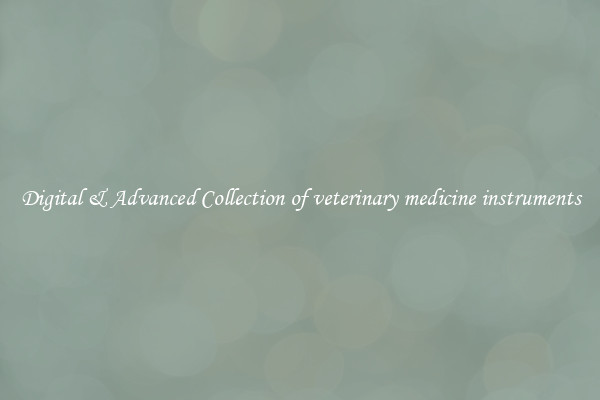Digital & Advanced Collection of veterinary medicine instruments
Digital & Advanced Collection of Veterinary Medicine Instruments

The field of veterinary medicine has seen significant advancements in recent years, especially when it comes to the collection of instruments used in various procedures. With the integration of digital technology, veterinarians now have access to a wide range of advanced tools that make diagnosis and treatment more accurate, efficient, and less invasive.
Digital imaging has revolutionized veterinary medicine by enabling veterinarians to capture highly detailed images of internal structures, leading to more accurate diagnoses. Digital radiography allows for instant image acquisition, eliminating the need for film processing. These images can be easily enhanced, zoomed in, and shared with colleagues for better collaboration. This advanced technology also reduces radiation exposure for animals and veterinary staff, making it safer for all parties involved.
Ultrasound technology has also gone through significant advancements in recent years. Veterinary ultrasound machines are now portable, allowing veterinarians to perform on-site examinations easily. Advanced ultrasound systems offer better image quality, helping veterinarians obtain more accurate measurements and identify abnormalities in organs, blood vessels, and tissues. This technology has proven particularly valuable in reproductive medicine, cardiology, and abdominal imaging.
Endoscopy is another area where digital technology has greatly improved veterinary medicine. Veterinary endoscopy involves the insertion of a flexible tube with a camera attached, allowing veterinarians to visualize internal organs and perform minimally invasive procedures. The introduction of high-definition, digital endoscopes has greatly enhanced visualization during procedures. The images are displayed in real-time on high-resolution screens, providing veterinarians with a clear view of the area being examined. This technology results in faster and more accurate diagnoses, minimal pain and discomfort for the animals, and shorter recovery times.
Digital monitoring equipment has also transformed veterinary medicine by providing real-time data on animal vital signs. These devices track heart rate, blood pressure, oxygen levels, and other important parameters, allowing veterinarians to continuously monitor their patients. Digital monitoring equipment is particularly useful in surgical and critical care settings, enabling veterinarians to detect any abnormalities or complications early on.
In conclusion, the digital and advanced collection of veterinary medicine instruments has greatly enhanced the field of veterinary medicine. Through the integration of digital technology, veterinarians now have access to high-resolution imaging, portable ultrasound machines, high-definition endoscopes, and real-time monitoring equipment. These advancements have improved accuracy in diagnosis and treatment, minimized invasiveness, and reduced recovery times for animals. The future of veterinary medicine is undoubtedly exciting as technology continues to evolve, further improving animal care and well-being.

View details

View details

View details

View details








